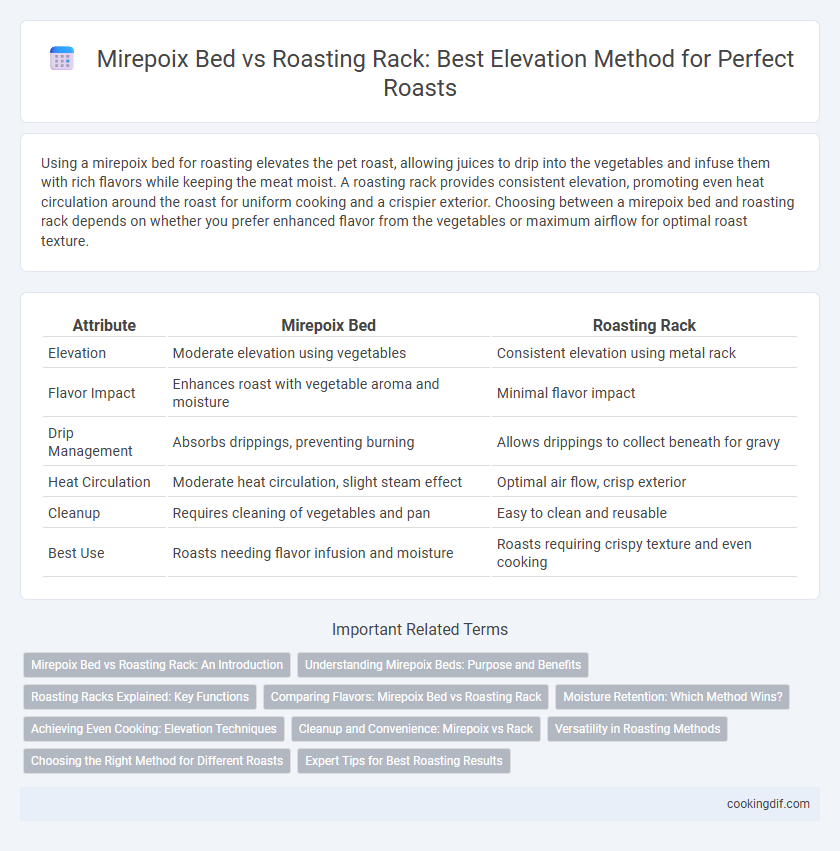Using a mirepoix bed for roasting elevates the pet roast, allowing juices to drip into the vegetables and infuse them with rich flavors while keeping the meat moist. A roasting rack provides consistent elevation, promoting even heat circulation around the roast for uniform cooking and a crispier exterior. Choosing between a mirepoix bed and roasting rack depends on whether you prefer enhanced flavor from the vegetables or maximum airflow for optimal roast texture.
Table of Comparison
| Attribute | Mirepoix Bed | Roasting Rack |
|---|---|---|
| Elevation | Moderate elevation using vegetables | Consistent elevation using metal rack |
| Flavor Impact | Enhances roast with vegetable aroma and moisture | Minimal flavor impact |
| Drip Management | Absorbs drippings, preventing burning | Allows drippings to collect beneath for gravy |
| Heat Circulation | Moderate heat circulation, slight steam effect | Optimal air flow, crisp exterior |
| Cleanup | Requires cleaning of vegetables and pan | Easy to clean and reusable |
| Best Use | Roasts needing flavor infusion and moisture | Roasts requiring crispy texture and even cooking |
Mirepoix Bed vs Roasting Rack: An Introduction
A mirepoix bed, composed of diced onions, carrots, and celery, creates a flavorful foundation that elevates meat while infusing the roasting pan with aromatic juices. In contrast, a roasting rack physically lifts meat off the pan, promoting even heat circulation and preventing sogginess by allowing fat to drip away. Both techniques enhance roasting results, but the mirepoix bed adds depth of flavor and moisture, whereas the roasting rack prioritizes crispness and browning through better air exposure.
Understanding Mirepoix Beds: Purpose and Benefits
Mirepoix beds, composed of diced onions, carrots, and celery, create a flavorful base for roasting by elevating the meat and allowing even heat circulation while infusing rich aromatics into drippings. Unlike a roasting rack, which primarily elevates meat to prevent sticking and promote browning, a mirepoix bed enhances depth and complexity of flavor during cooking. Using a mirepoix bed supports moisture retention and produces a savory base ideal for sauces and gravies from the roasted pan juices.
Roasting Racks Explained: Key Functions
Roasting racks elevate meat to allow even heat circulation, preventing it from sitting in its own juices and promoting uniform browning. Mirepoix beds, composed of chopped vegetables, serve as a flavorful base that infuses the meat with aromatic moisture while also lifting it off the pan. Using roasting racks enhances crispiness and airflow, whereas mirepoix beds contribute to depth of flavor and natural basting during roasting.
Comparing Flavors: Mirepoix Bed vs Roasting Rack
A mirepoix bed infuses roasting meats with rich aromatic flavors from carrots, onions, and celery, enhancing the overall depth and complexity of the dish. Roasting racks elevate meat to allow even circulation of hot air, promoting uniform cooking and crispier exterior textures without the added moisture or flavor from vegetables. Using a mirepoix bed imparts savory, sweet nuances to pan drippings ideal for sauces, while a roasting rack focuses more on texture and browning without the vegetal undertones.
Moisture Retention: Which Method Wins?
A mirepoix bed enhances moisture retention by creating steam during roasting, which helps keep the meat juicy and flavorful. In contrast, a roasting rack elevates the meat, allowing air circulation that promotes even browning but can lead to drier surfaces. For optimal moisture retention, the mirepoix bed is generally preferred as it maintains a humid environment that prevents excessive drying.
Achieving Even Cooking: Elevation Techniques
Using a mirepoix bed during roasting provides a natural elevation that allows air circulation beneath the meat, promoting even cooking and flavor infusion from the aromatic vegetables. In contrast, a roasting rack offers consistent elevation by lifting the roast above the pan surface, ensuring uniform heat distribution and crispier exterior texture. Both techniques enhance roasting results by preventing direct contact with fat or liquid, which can hinder browning and create uneven cooking zones.
Cleanup and Convenience: Mirepoix vs Rack
Using a mirepoix bed during roasting simplifies cleanup by absorbing drippings and preventing them from burning onto the pan, reducing scrubbing time compared to a roasting rack. The vegetable bed collapses and can be discarded after cooking, eliminating the need to wash additional equipment, whereas roasting racks require thorough cleaning to remove baked-on juices and fats. Mirepoix beds also enhance convenience by naturally elevating the meat while infusing flavor, minimizing the use of extra tools and streamlining the roasting process.
Versatility in Roasting Methods
Mirepoix beds provide a flavorful base that infuses roasting juices with aromatic vegetables, enhancing the depth of the meat's taste while preventing direct contact with the pan. Roasting racks elevate the meat evenly, promoting better air circulation and crispier texture by allowing fat to drip away during cooking. Using either a mirepoix bed or roasting rack depends on desired flavor infusion and textural outcomes, making them versatile tools tailored to different roasting methods.
Choosing the Right Method for Different Roasts
Using a mirepoix bed for roasting adds rich, aromatic flavor and moisture to meats like beef or pork, enhancing overall taste through vegetable caramelization. A roasting rack elevates poultry and lean cuts, promoting even heat circulation and crisp, golden skin by preventing direct contact with pan drippings. Selecting between a mirepoix bed and a roasting rack depends on the roast type and desired flavor profile, with mirepoix ideal for braises and racks best for dry heat roasting.
Expert Tips for Best Roasting Results
Using a mirepoix bed for roasting infuses the meat with rich, aromatic flavors and helps retain moisture during cooking. Roasting racks elevate the meat, promoting even heat circulation and a crispier crust by preventing the protein from sitting in its juices. Experts recommend combining both by placing the meat on a roasting rack set atop a mirepoix bed to maximize flavor infusion and elevate for optimal browning and juiciness.
Mirepoix bed vs roasting rack for elevation Infographic

 cookingdif.com
cookingdif.com